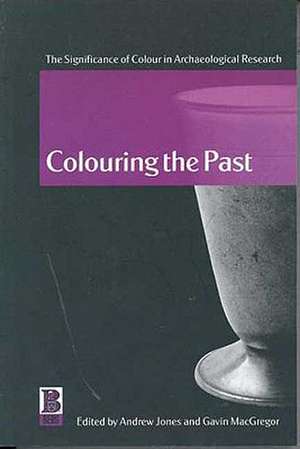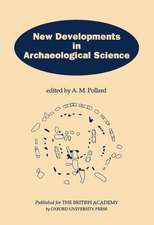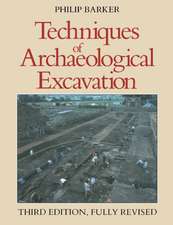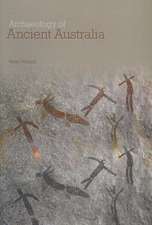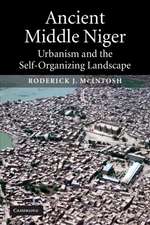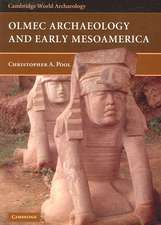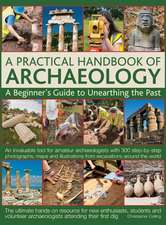Colouring the Past: The Significance of Colour in Archaeological Research
Editat de Andrew Jones, Gavin MacGregoren Limba Engleză Hardback – 30 iun 2002
| Toate formatele și edițiile | Preț | Express |
|---|---|---|
| Paperback (1) | 233.91 lei 6-8 săpt. | |
| Bloomsbury Publishing – 30 iun 2002 | 233.91 lei 6-8 săpt. | |
| Hardback (1) | 775.51 lei 6-8 săpt. | |
| Bloomsbury Publishing – 30 iun 2002 | 775.51 lei 6-8 săpt. |
Preț: 775.51 lei
Preț vechi: 901.75 lei
-14% Nou
Puncte Express: 1163
Preț estimativ în valută:
148.43€ • 154.36$ • 124.20£
148.43€ • 154.36$ • 124.20£
Carte tipărită la comandă
Livrare economică 15-29 martie
Preluare comenzi: 021 569.72.76
Specificații
ISBN-13: 9781859735428
ISBN-10: 1859735428
Pagini: 276
Ilustrații: 50 illus, 8pp colour section, biblio, index
Dimensiuni: 156 x 234 x 17 mm
Greutate: 0.62 kg
Editura: Bloomsbury Publishing
Colecția Berg Publishers
Locul publicării:London, United Kingdom
ISBN-10: 1859735428
Pagini: 276
Ilustrații: 50 illus, 8pp colour section, biblio, index
Dimensiuni: 156 x 234 x 17 mm
Greutate: 0.62 kg
Editura: Bloomsbury Publishing
Colecția Berg Publishers
Locul publicării:London, United Kingdom
Caracteristici
Also available in paperback, 9781859735473 £17.99 (July, 2002)
Notă biografică
Andrew Jones Lecturer in Archaeology,University of Southampton Gavin MacGregor Project Officer, Archaeological Research Division, University of Glasgow
Cuprins
PrefaceIntroduction: Wonderful things: colour studies in archaeology from Munsell to materiality Andrew Jones and Gavin MacGregor1. Apotropaism and the temporality of colours: colourful Mesolithic-Neolithic seasons in the Danube Gorges Dusan Boriç2. Colourful prehistories: the problem with the Berlin and Kay colour paradigm John Chapman3. White on blonde: quartz pebbles and the use of quartz at Neolithic monuments in the Isle of Man and beyond Timothy Darvill4. So many shades of rock: colour symbolism and Irish stone axeheads Gabriel Cooney5. The Flashing Blade: copper, colour and luminosity in north Italian Copper Age society Stephen Keates6. Munselling the Mound: the use of soil colour as metaphor in British Bronze Age Funerary ritual Mary-Ann Owoc7. Making monuments out of mountains: the role of colour and texture in the constitution of meaning and identity at Recumbent Stone Circles Gavin MacGregor8. A biography of colour: colour, material histories and personhood in the Early Bronze Age of Britain and Ireland Andrew Jones9. The composition, function and significance of the mineral paints from the Kurgan burial mounds of the South Urals and North Kazakhstan Alexander Tairov and A. F Bushamakin10. Colour and light in a Pompeian house: modern impressions or ancient perceptions Penelope M. Allison11. The colours of light: materiality and chromatic cultures of the Americas Nicholas J. Saunders12. Epilogue: colour and materiality in prehistoric society Chris ScarreNOTES ON CONTRIBUTORS Penelope M. Allison has taught ancient history and archaeology at the University of Sydney (Australia), the Australian National University and the University of Sheffield (UK). She has held research fellowships at the University of Sydney (Australia) and in the Faculty of Classics, Cambridge (UK). She is currently an Australian Research Council Queen Elizabeth II Fellow at the Australian National University. She has recently edited The Archaeology of Household Activities (Routledge 1999) and co-authored Casa della Caccia Antica, for the series Häuser in Pompeji (Hirmer, Munich) and authored Pompeian Households (The Cotsen Institute of Archaeology at UCLA). Dusan Boric is currently completing his doctoral research on the topic of 'Mesolithic-Neolithic time views: seasons and life cycles in the Balkans, c. 9000-5500 BC ' in the Department of Archaeology, University of Cambridge (UK). His current research focuses on the Early Holocene archaeological sequences of the Danube Gorges of Serbia and the sites of Lepenski Vir, Padina, Vlasac and Hajducka Vodenica with an emphasis on subsistence practices, mortuary data and domestic architecture. He is interested in exploring theoretical aspects of archaeological inquiry that can contribute to the wider field of social theory. These include questions of apotropaism, temporality and the political nature of archaeological practice. The late Anatoli Filippovich Bushmakin worked at the Institute of Mineralogy, Urals Branch of the Russian Academy of Science (Russia) in collaboration with Alexander Tairov.Gabriel Cooney is a Professor in the Department of Archaeology, University College Dublin (Ireland). He is the author of numerous articles on the Irish Neolithic, landscape archaeology and archaeological theory. He recently published 'Landscapes of Neolithic Ireland' (Routledge, 2000).John Chapman is a Reader in Archaeology in the University of Durham (UK) with research interests in archaeological theory, settlement, mortuary studies and social structure. He has worked for over 30 years with the Mesolithic, Neolithic and Copper Age of Central and Eastern Europe. He recently published a ground-breaking book 'Fragmentation in archaeology' (Routledge, 2000). His late
Recenzii
'Until recently archaeologists were remarkably insensitive to the importance of colour in ancient societies. This book changes the situation. It offers a series of provocative and persuasive studies which will surely influence a new generation of research. It will help to stimulate a more imaginative approach to fieldwork and richerinterpretations of the past. All archaeologists should read it and learn from what it has to say.'Richard Bradley, Reading University
